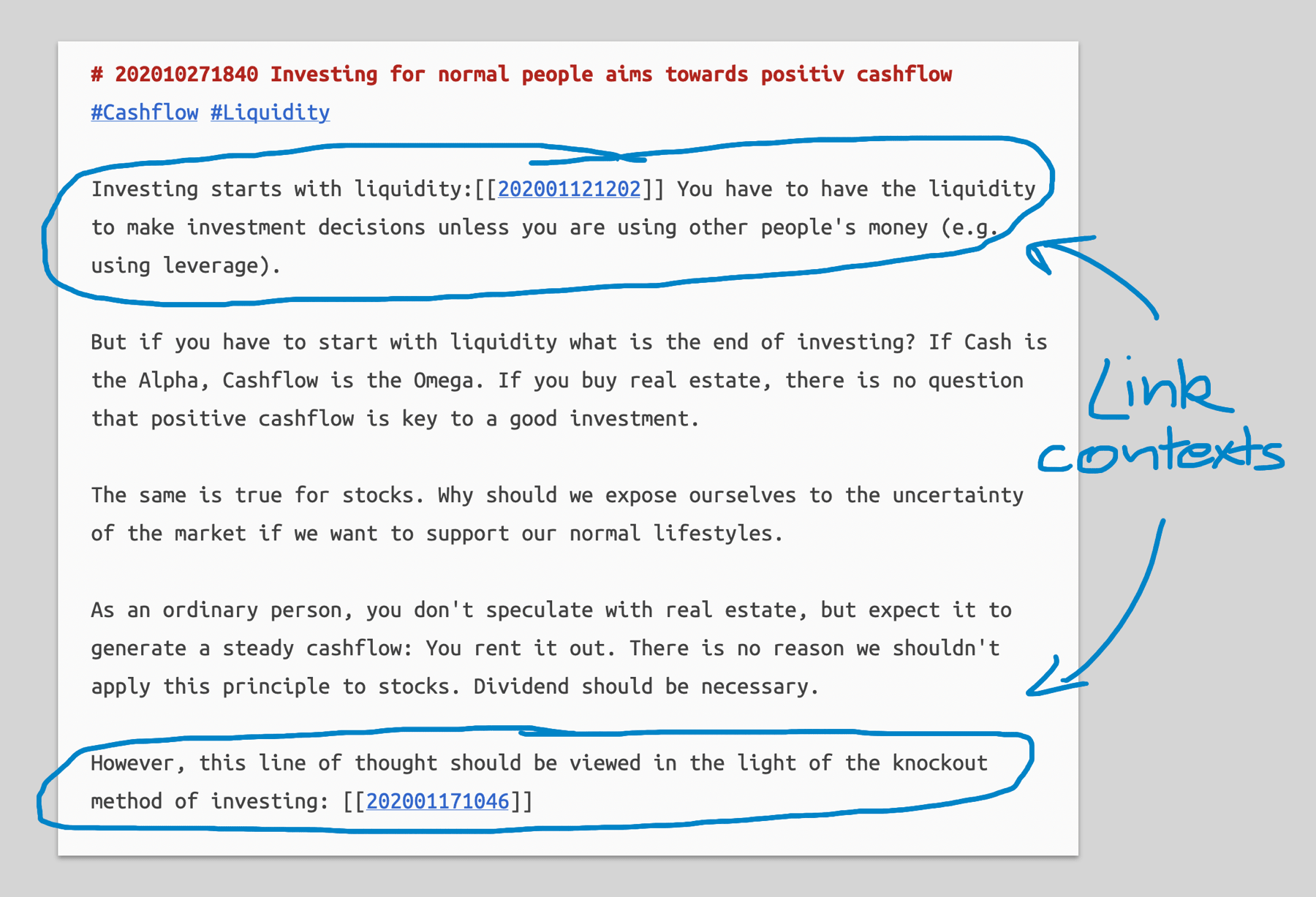RE: Backlinks Should Be Context-Rich
Jared Gorski wrote a response to my article “Backlinks are bad links”. Since it’s a short and concise response, a re-response is warranted. He summarised my point fairly and sufficiently, so I don’t need to repeat myself here. If you are not familiar, please read the article linked above. I’ll reply to Jared’s post point by point.

Ad: Backlinks are part of a note
Jared wrote:
Still, backlinks do the helpful work of acknowledging connections to a particular note, which may be more helpful than harmful in terms of helping a note to more fully represent the concept being encapsulated.
If I understand it correctly, Jared states that backlinks provide value by presenting the user with the fact that there are links directed at a note. I think Jared has a point. The fact that you are presented with some representation of the network can give you orientation for the location of the current note within the network of notes.
However, I think he is missing the opportunity costs that such a presentation entails. The more you link to a note the more backlinks are presented to you if you review this note. There is a tipping point: The list of backlinks becomes too big to be reviewed at one (or two) glances. It becomes an additional cognitive burden, and the burden increases the more you link to the note. It is a losing game if you play it for a long time (which is part and parcel of a Zettelkasten). However, if you use a Zettelkasten (or any integrated thinking environment, a term Thomas Teepe coined) just for one project you’ll be fine and backlinks would not suffer from this bloat.
Ad: Backlinks are intentional
Jared wrote:
In this way, backlinks are intentional because they’re simply a feature of the initial forward link they represent.
This looks like a fallacy to me. Becoming fat is a feature of eating fast food on a daily basis. But I would be very suprised if becoming fat is intented by as many people as there are regular fast food eaters.
Jared wrote:
This forward link was intentional, so the connection between the concepts is meaningful, even if that connection is represented in the connectee (not just the connector).
This is a good point. The question is: How is intention in linking connected to the meaning of the link? Technically, there is no obligatory connection. I could intentionaly create meaningless links, after all. Or, I might fail to create meaning at all.
But let’s assume that I am neither a joker nor a failure, and the meaning of the link is available to me. I know the meaning and create a representation of the meaning next to the link.

The meaning of the link is represented in what I call the link context. I not only place a link but also provide why I placed it, and thus give my future self a good reason to follow the link. This consciously represented meaning, the link context, is not given by a backlink. It cannot be, because I didn’t place it consciously.
I can give myself a good reason to follow the link I placed. But I cannot give myself a good reason to follow the backlink. The backlink could have hidden meaning that I could represent if I review the backlinks of the note. Then it would be my task to represent this hidden meaning. This would transform the backlink into a consciously placed forward link.
There is a technical reason why this is this way.
If you place a forward link you reduce all the possibilities of linking to just one. It is not only very selected, it is more selected the bigger your Zettelkasten grows. The backlink, however, might too be just a single link in itself at first, but in the long run, it is just a part of an ever growing backlink apparatus.
Forward links are specific, and if carefully placed, are enriched with good reasons why they were placed. But backlinks do not inherit this specificity. They are (if placed automatically) basically just the statement that there is a link to that file.
Meaning is created by intimate interaction: Our personal relationships are meaningful on the basis on their intimacy. I cannot be as intimate with each member of my harem as I am able to be with my wife.1 I cannot be as intimate with my horde of acquaintances as I am able to be with my best friend. I cannot be as intimate with any dog I meet as I am able to be with my own dog. I cannot be as intimate with any book as I am able to be with my favorite book that I read over and over. I know, this is not a formal argument. But I trust you to get my point.
Ad: Backlinks should be context-rich. Then they are meaningful
Jared wrote:
Forward links are meaningful because they exist in context. To ensure backlinks are meaningful, backlinks should be context-rich:
- Note titles should express note content.
- Backlinks should provide some contextual data about the usage of the concept in question
First let’s test each condition on its own.
First, do good titles (I agree with Jared’s linked statement on note titles 145%) provide link context (representation of meaning)? No. Good note titles represent the content of the note. Not one iota is related to a connection. Otherwise, the title would not be accurate.
Second, can contextual data be meaningful? I think by “contextual data” Jared means what he proposes at the end his post: If you hover over a link, the software shows you the section in which the forward link was placed.
Even if you have the link context of the forward link at hand, the reason why you might go from one note to the other, there is still no good reason why to follow the opposite direction. If you review the backlink, you still have to assess if the other direction is also meaningful. If the direction is indeed meaningful, you’ll capture this newly found reason in the note with the backlink and thus manually add a representation of meaning. This would transform, as stated above, the backlink into a forward link.
However, I struggled a bit to make the last point. So, there might be some use to backlinks if your note-taking software (or other tools like Andy Matuschak’s note-link-janitor) provides you with the surrounding text that I don’t see.
I never encountered any actual use case in the realm of note-taking and integrated thinking environments. The only examples are given by public knowledge presentations like manuals or public notes. It is very different to use a system to produce knowledge versus using a system to reproduce (represent) knowledge. So, if you have a use case I am happy to review it, especially in the form of a video presentation.
Thanks, Jared Gorski, for your great article. I don’t share your opinion but I gladly share a place of good debate!
-
I hope it makes your life more exciting if I don’t clarify if I have a harem, a wife, both, or neither. ↩